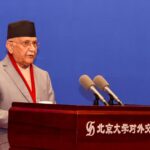On December 3, the Internet Society of China, the China Association of Automobile Manufacturers, the China Semiconductor Industry Association, and the China Association of Communications Enterprises issued statements declaring that US chip products are no longer safe and reliable, calling on domestic companies to exercise caution when purchasing US chips. The day before, the US government announced a new round of export curbs on China, adding over 140 Chinese companies to the Commerce Department’s entity list, involving various types of semiconductor products such as semiconductor manufacturing equipment and electronic design automation tools. It has also expanded its “long-arm jurisdiction” to restrict trade between China and third countries. Although the US government and some US media outlets have exaggerated the effects of these measures, the facts have repeatedly shown that such suppression cannot intimidate or halt the development and progress of China’s technology industry.
The relevant restrictive measures from the US are akin to a shoe that has long been expected to drop. Reports indicate that most of the content had been composed by the middle of this year and was known to many in the industry. The release was delayed owing to negotiations with US allies and chip-equipment companies. These negotiations took months and involved multiple revisions to the policy. Industry giants reportedly spent more than $4 million collectively lobbying in the US as a result. The final document, spanning over 200 pages, has been criticized as “extremely complex” and “riddled with loopholes.” The very process and outcome of its creation highlight the absurd nature of the policy, as it goes against the historical trend and undermines the interests of the majority of companies and individuals, making it destined for difficult implementation and unlikely to achieve the intended effects.
This is a blatantly arbitrary measure. Among the over 140 Chinese companies listed, some are included merely for having business dealings with Huawei, while others are deemed as “posing a risk to US national security,” for participating in the acquisition of US high-tech companies.
The US has used this measure to greatly expand its power, affecting many countries and regions, including Japan, the Netherlands, Israel, Malaysia, Singapore, South Korea, and China’s Taiwan region. This will severely disrupt the stability of the global industrial and supply chains and undermine the international economic and trade order. It’s equivalent to the US falling ill while forcing the rest of the world to “take the medicine.”
Currently, the vast majority of mainstream international opinion does not favor this new measure, believing it will only enhance China’s determination and capability to build a self-sufficient semiconductor industry. This marks the third round of US restrictions on chip exports to China in recent years.
Each round of measures has expanded the list and implicated more countries and regions, trapping the US in a logical deadlock. The initial logic of suppressing and containing China is flawed; not only will it fail to curb China’s technology industry, but it will also have the opposite effect.
The latest restrictions will lower to zero the amount of US content that determines when certain foreign items are subject to US control. In other words, if a product contains even a single chip designed or manufactured using American technology, the US government will restrict its shipment to Chinese companies on the list.
Such regulations may seem intimidating, but their actual effect is close to zero. The US has long implemented similar “supply cut” measures against Huawei; however, this has not prevented Huawei’s “upward transformation,” which serves as a typical example. The New York Times bluntly states that China is home to most of the world’s electronics factories and is a huge consumer market in its own right. Therefore, engaging in trade and cooperation with China around semiconductors is inevitable; it is a natural flow within the global supply chain.
It must be pointed out that several industry associations in China have called for “caution” in buying US chips, primarily due to the US’ neglect of the stability and security of the global industrial and supply chains. These associations’ calls are necessary and do not contradict China’s commitment to expanding independent opening-up. The development of China’s technology industry is rooted in globalization; it has grown and strengthened through this process and will continue to actively deepen cooperation with enterprises from various countries in the future to promote the prosperous development of the global industry. This direction will not be shaken.
Some individuals in the US seek to hinder China’s technological exchanges with other countries, including the US, which will inevitably result in China connecting even more closely with other nations, ultimately leaving the US isolated. The ongoing “de-Americanization” that some countries around the world are pursuing, starting from the financial sector, is a direct reflection of this trend. If the global semiconductor industry is a race involving many boats, Washington is like a ship that has veered off course, posing significant risks to other vessels. Global technological development is a community, and returning to the larger team of cooperation is the only wise choice for the US. We hope that Washington will recognize this sooner rather than later.
GT




